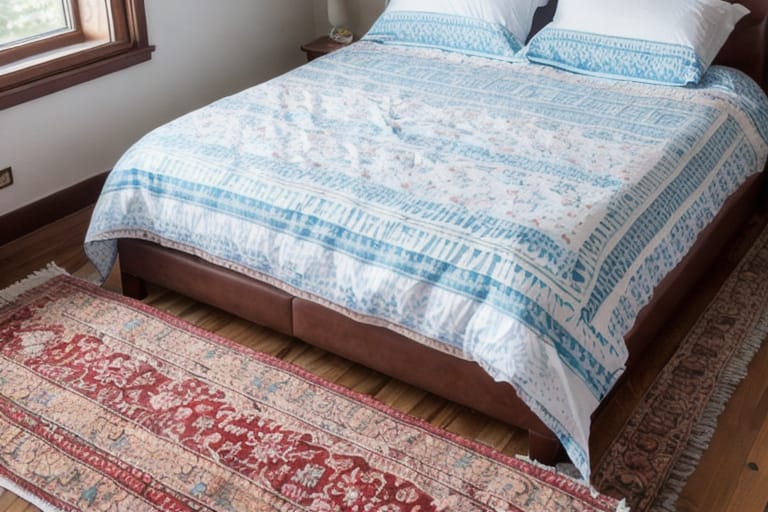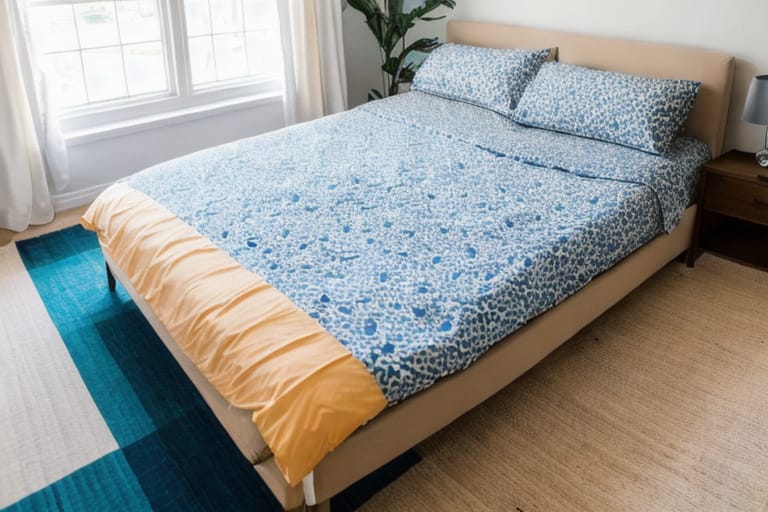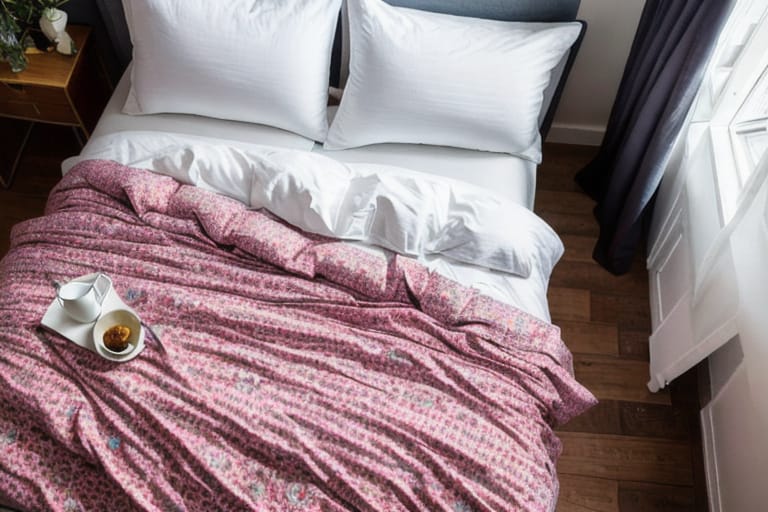Do you find yourself confused when shopping for bedding, wondering what exactly the difference is between a down comforter, a duvet, a quilt, and a blanket? You’re not alone – bedding terminology can be complex. But understanding the basics helps you choose bedding that offers superior comfort, quality construction, and stylish design.
In this beginner’s guide, we’ll unravel the mysteries of down comforters and other bedding essentials. You’ll learn how down comforters provide unbeatable softness and warmth, what makes duvets and quilts unique, how to select the perfect blanket for your needs, and more. We’ll also explore factors that impact your bedding choices like ethics, sustainability, and coordination.
Arm yourself with knowledge and take the guesswork out of creating a beautiful, cozy sleep space. Let’s get down to the basics of down comforters and beautiful bedding!
A Primer on Bedding
Before diving into specifics on down comforters and other bedding types, let’s clarify some key terminology that often causes confusion:
- Comforter – A flat, decorative bed covering filled with batting, down, feathers, or an alternative fill material. Meant to sit on top of bed sheets and provide extra warmth. May be used alone or with a duvet cover.
- Duvet – A soft flat bag filled with down, feathers, or an alternative filling. Inserted inside a duvet cover to create a complete bed covering.
- Quilt – A decorative bed cover with a top stitch design and a layer of batting or down between the top and bottom layers. May be used as a comforter.
- Blanket – A flat woven bed covering intended to provide warmth. Lighter than a comforter or quilt.
Now let’s explore each of these bedding types in more detail so you can select products to create your perfect sleep space.
The Warmth and Softness of Down Comforters
What Are Down Comforters?
Down comforters consist of an outer fabric shell filled with a plush down interior to provide cushioning and insulation. The shell is often made from lightweight fabrics like cotton, cotton blends, or microfiber to allow air circulation. Inside, clusters of delicate down feathers trap body heat. This creates a warm, breathable bed covering that adjusts to your temperature needs.<Insert image of down comforter with a cut-away or transparent section to show interior fill and construction>
Caption: Down comforters feature a lightweight shell filled with fluffy down material for superior warmth.
Why Choose a Down Comforter?
Down comforters offer exceptional benefits including:
- Warmth: Down traps air to provide superior insulation against the cold. Down comforters keep you cozy on even the chilliest nights.
- Lightweight: Despite their warmth, down comforters remain lightweight and breathable. Easy to add or remove during temperature fluctuations.
- Softness: Feathery-soft down cushions your body gently while resisting body impressions over time. Provides plush comfort.
- Durability: With proper care to maintain loft and prevent moisture damage, a quality down comforter will last over 10 years.
- Adjustability: Down provides flexible insulation that adapts as you add or remove layers underneath. Allows custom warmth control.
Down offers the highest warmth-to-weight ratio of any bedding insulation material. It’s nature’s best insulator, unrivaled for resilient flexibility, cloud-like softness, and lasting durability.
Down Comforter Fill Power and Other Factors
When selecting a down comforter, pay attention to:
Fill power – This measures volume and indicates down quality. Higher numbers like 600-900+ fp mean larger, more resilient down clusters that trap more air.
Construction – Look for baffle-box stitching into small sections to prevent shifting and maintain even distribution of fill. Avoid less durable sew-through boxes.
Shell fabric – Lightweight, breathable fabrics like cotton sateen or cotton blend are best. Ensure the weave is tight enough to contain feathers.
Ethical down certification – Responsible Down Standard (RDS) or Traceable Down Standard (TDS) certification indicates ethical treatment of geese/ducks.
Price – Expect to invest $200+ for a quality queen down comforter with nice shell fabrics and 500+ fill power.
The Versatile Open-Ended Design of Duvets
Duvet vs. Comforter – What’s the Difference?
While down comforters and duvets both provide plush softness and adjustable warmth, duvets feature a more versatile open-ended design:
- Duvets consist of a lightweight down insert covered by a decorative duvet cover. Inserts and covers are sold separately.
- Comforters are one-piece bed coverings with down encased inside an attached fabric shell.
With duvets, you can easily change covers to alter your bedroom look while reusing the same down insert. Duvet covers also protect the delicate down interior and are easier to clean than comforters.<Insert image contrasting duvet vs. comforter>
Caption: Duvets feature a removable cover that allows customization of your bedding look.
Why Add a Duvet to Your Bed?
Benefits of duvet systems include:
- Customization – Easily change duvet covers to match your mood or decor. Use multiple covers to rotate seasonally.
- Protection – Duvet covers shield the down insert from body oils and other stains.
- Easy cleaning – Only duvet covers need regular washing rather than more delicate down inserts.
- Allergen control – Those sensitive to down can use hypoallergenic synthetic inserts with the style of their preferred covers.
- Adaptability – Insert warmth meets all seasons while cover changes freshen up looks.
Choosing Duvet Inserts and Covers
Duvet inserts should match your climate needs and bed size. Pay attention to fill power, materials, stitching, and dimensions.
Duvet covers come in fabrics like cotton, linen, silk, flannel. Look for durable construction with hidden closures and corner ties to keep inserts in place inside.
For a coordinated designer look, select a duvet cover and insert from the same collection. Mix and match for more eclectic style.
Quilts Add Charming Style to Beds
Decoding Quilts
Quilts make beds extra cozy while working double duty as decorative accents. By definition, quilts consist of:
- A stitch-patterned top layer
- Fluffy fill material (down, wool, cotton, synthetics)
- A backing layer
Sandwiching fill between decorative top fabric and backing creates charming texture and dimension. Quilts may be used as alternatives to comforters.<Insert close-up image of intricate quilt stitching pattern>
Caption: Beautiful hand- or machine-stitched designs give quilts artistic flair.
Quilt vs. Duvet vs. Comforter
While duvets, comforters, and quilts all provide warmth, quilts offer extra style. Design differences include:
- Appearance: Quilts feature intricate decorative stitching for artistic flair.
- Function: Quilts insulate like comforters but don’t replace top sheets like duvets. May be used over or under bedcovers.
- Fill: Quilts have stitching that holds fill in place and prevents shifting. Wider variety of fill materials used.
- Versatility: Quilts sometimes do double duty as wall hangings or table coverings for extra decor.
For those seeking beauty and charm, a quilt brings artistic interest to your nest.
Crafting Cozy Quilt Layers
Designer quilts allow you to select each layer to customize:
- Top fabric like cotton, flannel, silk
- Fill material like down, wool, cotton, microfiber
- Backing fabric like flannel or printed cotton
- Stitch patterning like patchwork, applique, embroidery, quilting
Mix and match elements for personalized style then bask under your custom creation!

Finding the Perfect Blanket for You
Understanding Blankets
At its simplest, a blanket provides an extra layer of warmth at the end of beds or on sofas. Key features include:
- Typically thinner and smaller than a comforter or quilt
- Made from woven fabrics like wool, cotton, faux fur, fleece
- Provides light, movable warmth when you want to curl up cozily
- Easy to fold away or store at the foot of beds when not needed
Comparing Blankets to Comforters and Duvets
While comforters and duvets serve as decorative bed covers, blankets play a more utilitarian warmup role. Think of blankets as versatile, movable layers offering additional warmth and comfort wherever you want it.
Choosing Your Ideal Blanket
Consider what, when, and how you use a blanket to select the ideal features:
Materials – Light, breathable cotton and wool for summer; thick, plush fleece or faux fur for winter.
Size & shape – Match to bed size for layering or smaller throws for snuggling.
Weight – Heavier blankets in cold months; lighter versions for warm conditions.
Textures & touches – Look for extra coziness factors like long-pile faux fur or chenille knit fabrics.
Down vs. Down Alternative: Which is Best?
The Natural Benefits of Down Fill
Down comforters and featherbeds brim with natural advantages:
Warmth – Aerodynamic down cluster design from waterfowl traps more body heat. Unbeatable insulation.
Comfort – Airy, fluffy texture adapts to your shape for cloud-like softness and support.
Durability – Resilient down maintains loft and insulation capacity through years of use.
Breathability – Lightweight down allows excellent airflow and moisture wicking unlike synthetic fills.
For those seeking responsibly-sourced natural materials, down delivers stellar comfort, warmth, and longevity.
Exploring Down Alternative Fill Materials
If avoiding animal products is important or down allergies are a concern, down alternative fills make decent substitutes including:
- Polyester fibers – Shredded cut strands mimic down properties
- Microfiber clusters – Faux down balls provide cushioning
- PrimaLoft® – Ultra-fine microfiber engineered for compression resistance
While less breathable and durable than true down, down alternatives provide similar lightweight warmth. PrimaLoft offers closest natural down performance.
Choosing Between Down and Down Alternative Fills
| Consider… | If choosing DOWN | If choosing DOWN ALTERNATIVE |
|---|---|---|
| Allergies/sensitivity | Avoid – contains natural proteins that can trigger allergic reactions | Best choice – hypoallergenic synthetic fills |
| Animal welfare | Ensure certified RDS or TDS ethical down sources | Better for vegans/vegetarians avoiding animal products |
| Budget | Higher initial cost | Generally lower upfront cost |
| Breathability | Excellent – remains fluffy and breathable through use | Varies – some synthetics flatten more over time |
| Durability | Longest-lasting – retains loft and insulation with care | Shorter lifespan – tends to compress/flatten faster |
| Warmth | Maximum warmth for weight; superior insulation | Good warmth, but not as efficient as down |
Factors Influencing Your Bedding Choices
Beyond fill materials, several other factors impact which bedding options best meet your needs. Consider what matters most regarding:
Warmth and Insulation
Do you tend to sleep hot or cold? How many layers and weight of bedding keeps you comfortable in various seasons? Pay attention to insulation properties like fill power, shell fabrics, and construction to make choices balancing your needs for coziness versus temperature regulation.
Aesthetics and Decor
The style, patterns, colors, and textures of your bedding significantly impact how your bedroom looks and feels. Do you prefer matching collections or eclectic mixes? Want your bedding to complement your walls, furniture and accents or make a bold statement? Factor aesthetics into bedding selections.
Practicality and Care
How heavy your bedding is and how it fits your bed plays a role in enjoyment. And easy-care bedding saves work. Compare shell fabrics, dimensions, stitching durability and cleaning requirements as you shop.
Ethics and Sustainability
If sourcing, organic materials, dyes or labor practices are important to you, vet brands thoroughly and look into third-party certifications. Responsible down certification programs help ensure humane practices for geese/ducks. Eco-friendly synthetics like recycled polyester offer greener options.
Prioritize what matters most regarding comfort, design, practicality and values to guide choices.
Creating Coordinated Bedding Ensembles
One of the joys of selecting all your own bedding elements separately lies in options for coordination. Follow designer principles for creating stunning layered bedscapes.
Why Coordinate Bedding?
An artfully coordinated bedding ensemble creates a pulled-together, upscale look. A mix of complementary patterns, colors and textures ups the visual interest. Mixing materials like cottons, linens and silks adds dimension.
Tips for Pleasing Bedding Combinations
- Select a color palette and stick to 2-4 colors in your scheme
- Choose a mix of large and small patterns; avoid clashes
- Repeat colors throughout layers for continuity
- Use tones of a color (light blue, medium blue, navy)
- Incorporate multiple natural fiber textures (linen, cotton chenille)
- Mix elegant materials like silk, cashmere with casual cottons
- Anchor with solid shams/duvets; add prints on decorative pillows
Having fun with creative combinations opens a world of stylish possibilities!<Insert image collage with examples of nicely coordinated bedding layers>
Caption: Coordinate bedding for a designer look by repeating colors, mixing patterns, and adding lush textures.
Quality Bedding Materials & Construction
Understanding materials and manufacturing methods helps evaluate bedding quality. What goes inside and outside your bedding significantly impacts performance factors like long-term durability, breathability, easy care and allergen resistance.
Three-Layer Bedding Construction
Quality comforters, duvets and quilts feature three integrated layers:
- Decorative outer shell – Protective fabric layer touching skin
- Insulating fill material – Down or down alternative fibers
- Inner lining – Separates fill from shell; supports baffles
Durably securing all three layers together ensures fill stays evenly distributed inside for consistent insulation.<Insert cutaway image showing bedding construction layers>
Caption: Well-constructed three-layer bedding contains inner fill securely between backing and shell.
Outer Shell Fabric Options
Common shell fabrics include:
- Cotton – Natural, breathable, moisture-wicking
- Polyester – Colorfastness, wrinkle/fade resistance
- Linen – Natural luxury; textured appearance
- Sateen – Smooth cotton with lustrous sheen
- Flannel – Soft, warm brushed cotton
High thread counts, tight weaves, mercerization (for sheen), and fabric finishes like calendaring all boost durability.
Inner Lining Fabrics
Inner linings provide insulation stability and support. Materials like:
- Cotton – Breathable
- Polyester – Strength
- Cambric – Thin, crisp cotton often in duvets
Low-friction fabrics allow free down/fill movement inside baffled channels.

Bedding Shopping Guide
Armed with knowledge on bedding fill materials, construction quality, and design options, you’re ready to start shopping. Use these tips for sourcing bedding good enough to dream on.
Reading Bedding Tags
Tags on duvets, comforters and pillows provide helpful details:
- Fill content % – 90+% down superior; down alternative less breathable
- Fill power – Higher numbers indicate more insulation
- Certifications – Responsible Down Standard (RDS); OEKO-TEX, Organic
- Fabric content – Benefits of cotton, polyester, other fibers
- Dimensions – Fit your mattress height/depth
- Care instructions – Washing method depends on materials
Get familiar with standard terms and labeling to understand quality.
In-Store Shopping Strategies
When seeing and touching products boosts evaluation, use these store tips:
- Assess fill – Plumpness indicates good resilience; avoid clumping/shifting
- Feel shell fabric – Smooth, tight weave; check softness
- Zippers & closures – Sturdy, durable; hidden on duvets
- Peek inside – Evenly distributed baffles; no gaps/thin spots
- Shake gently – Fill shouldn’t shift/clump; mills around freely
Try out display floor models when possible before purchasing bedding.
Buying Bedding Online
For convenience and expanded options, many people shop bedding online. Best practices include:
- Read reviews – User feedback identifies quality, sizing, comparisons
- Contact customer service – Get info straight from the source
- Check policies – Shipping, returns, warranties – know what to expect
- Compare specs – Fill power, materials, certifications, pricing
- Join loyalty programs – Save $ with member discounts and sales access
Do your homework and you can confidently
Frequently Asked Questions
Still have some questions about down comforters and other bedding essentials? Here are answers to some common queries.
What’s the difference between a comforter and a duvet?
A comforter is a one-piece decorative bed covering filled with down or an alternative to provide warmth. A duvet consists of two separate pieces – a lightweight down-filled insert covered by a decorative duvet cover. Duvet covers allow for easy changing of looks and provide protection for the down insert inside.
How do I know if a down comforter is good quality?
Look at the fill power (preferably 600+), the fill percentage (90%+ down recommended), and quality name brands when selecting a down comforter. Avoid products with shifting fill inside. Check that shell fabric has a tight weave and felt construction keeping fill securely baffled into sections.
Why choose a down-filled duvet over alternative-filled?
Down offers superior breathability, durability, and lightweight adjustable warmth compared to alternative fills like polyester, PrimaLoft, or microfiber. Natural down contours gently around the body for cloud-like softness and support. If avoiding animal products is preferred, synthetic fills make decent substitutes.
What’s the benefit of using a duvet cover?
Duvet covers allow you to easily change your bedding look by swapping out stylish covers. Covers also protect the duvet insert from body oils, spills, etc. so the delicate down inside stays cleaner. Only duvet covers need regular laundering rather than washing the entire duvet insert each time.
How do I wash and care for my down comforter or duvet?
Follow any specific care label directions. In general, gentle machine washing on a delicate cycle with mild detergent avoids damage. Skip the agitation cycle, and never overload washers. Tumble dry using low heat with clean tennis balls to restore loft. Store flat when not in use.








